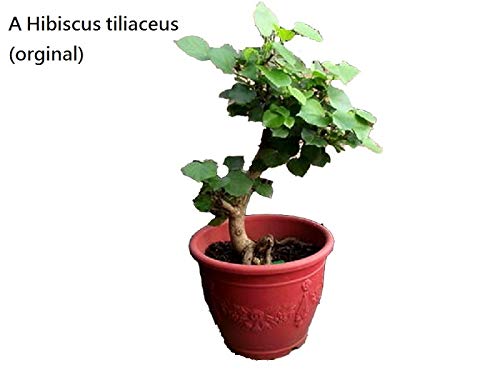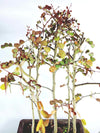

Hibiscus Tiliaceus Sapling Live Plant for Bonsai Training
Rs. 799.00
Guaranteed Safe Checkout
Hibiscus has Lovely Deep Green, Native to Hawaii. Used widely in Taiwan and Indonesia for their excellent Ability to Ramify and Speed of growth. Widely Used For Bonsai .Sea Hibiscus Likes Full Sun and Moderate Eater and Fertilizer. Tropical tree, keep away from Freezing Temperatures!
-
Grow potted hibiscus plants in loamy, lightweight soil. Hibiscus plants aren’t that particular about their soil mix, but they prefer lightweight material such as loam and peat moss. A regular bag of potting soil will usually work just fine. You can create their ideal soil conditions by mixing 1 part garden loam, 1 part peat moss, and 1 part fine sand or bark.
- A mix of 1 part coarse peat, 1 part composted bark, and 1 part composted manure mixed with a little bit of leca and vermiculite is also a great soil mix for hibiscuses.
-
Make sure the planter or container drains well. Loamy soil provides good drainage, but it's also important to grow hibiscuses in containers or planters that have plenty of drainage holes. After a watering, the environment should drain completely to prevent root rot. Water your plant, then watch for the water to come out of the drainage holes. Let the water drain into the plastic tray underneath
- Give the roots time to soak up the excess water, but if water is still in the tray after 12 hours, dump it out.
4
Give your hibiscus plants warm water. Never use cold water on hibiscus plants. They like their water to be around 95°F (35°C). Use a thermometer or touch the water with your hand before administering it to check the temperature. Avoid using water that's much hotter than 95°F (35°C), since they don't like overly warm water either.
𝗥𝗲𝗹𝗮𝘁𝗲𝗱 𝗽𝗿𝗼𝗱𝘂𝗰𝘁𝘀
Flowering Plants
Green Paradise® Pink Lotus Tuber for Pond & Water Gardens – Healthy, Ready to Grow Aquatic Flower Plant Bulb
Green Paradise® Pink Lotus Tuber – Premium Aquatic Flower Plant ✨ Product Description: Bring the beauty of vibrant pink lotus blooms to your water garden or pond with the Green...
Rs. 549.00
Flowering Plants
Rare Heliconia Wagneriana Live Plant Heliconia psittacorum Live Plant
Introducing the Exquisite Heliconia Psittacorum Plant: A Tropical Marvel for Your Home Elevate your indoor and outdoor spaces with the captivating beauty of the Heliconia Psittacorum Plant. Renowned for its...
Rs. 499.00
Flowering Plants
Green Paradise Live-Heliconia Wagneriana Plant with Plastic Pot
Green Paradise Offer Beautiful Heliconia Wagneriana Plant About Heliconia Wagneriana Plant Heliconia wagneriana is a stunning and attractive tropical plant known for its unique and colorful inflorescence. Here's what I can...
Rs. 499.00
Flowering Plants
Heliconia rostrata Live Plant heliconia plant Heliconia psittacorum Live Plant
Introducing the Heliconia psittacorum Plant – Nature's Exotic Masterpiece! About Heliconia Psittacorum Plant: Elevate your garden to new heights with the breathtaking Heliconia psittacorum Plant, a true marvel of nature....
Rs. 499.00
Outdoor Plant
Green Paradise® Water Rose (Pistia) – Live Water Cabbage Aquatic Plant for Ponds, Aquariums & Water Gardens | Natural Oxygenating Floating Plant
Green Paradise® Water Rose (Aquatic Pistia) Plant Welcome to the lush world of Green Paradise® Water Rose (Aquatic Pistia)! Our aquatic plant is more than just a decorative addition to your...
Rs. 399.00
Seeds
Heliconia Golden Torch plant bulbs positive energy and beautiful flowers giving Plant species. (pack of 3)
Green Paradise offers Heliconia Golden Torch Plant About Heliconia Golden Torch Plant Heliconia Golden Torch is a beautiful and striking tropical plant known for its bright and vibrant inflorescence....
Rs. 399.00
Seeds
Heliconia Plant Bulbs Heliconia bihai x marginata 'Rauliniana' 5 Bulbs-Green Paradise Live
Green Paradise Offers Heliconia bihai x Marginata Rhizomes (Pack of 5 Bulbs) About Heliconia Marginata Heliconia marginata, also known as the Red Bassy or Lobster Claw, is a stunning tropical plant...
Rs. 749.00
Flowering Plants
Heliconia bird of paradise Live healthy Plant-Green Paradise Live
Green Paradise Offers Beautiful Heliconia Bird Of Paradise Plant About Heliconia Bird Of Paradise Plant It seems like there might be a slight confusion in your question. Heliconia and Bird of...
Rs. 349.00






